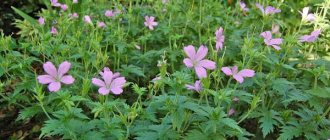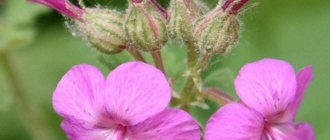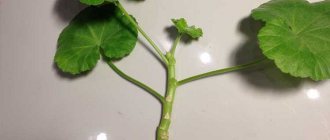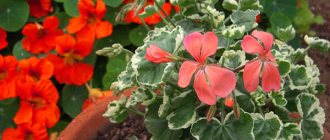Geranium has long been loved by flower growers. She is unpretentious in content. Almost all types of plants delight with long and colorful flowering. The vast majority of pelargonium species necessarily require shortening of stems and pinching. This is the key to their luxurious flowering in the coming season. When and how to prune geraniums for the winter, the flower itself will tell you. As soon as it throws off the last faded buds, you can start. Properly pruning geraniums for the winter is not difficult at all.
Need for pruning
Pelargonium is pruned regularly; the choice of season (spring or autumn) is determined by flowering time and variety. This is necessary for:
- obtaining fresh shoots;
- variety propagation;
- formation of an even and dense crown;
- improving air exchange.
At the same time, old dry branches, shoots growing in the direction of the stem and interfering with each other, branches that lack foliage and inflorescences are removed.
Autumn pruning is more reasonable than spring pruning. At this time, the geranium is preparing to rest. The process prepares it, facilitates wintering, and promotes lush flowering in summer.
Main varieties and varieties of geraniums
In gardens you can see a wide variety of plant varieties, distinguished by a variety of shades. The color palette does not yet include only orange and yellow. Among the species differences are not only the color and size of the flowers, but also the height of the bush, requirements for cultivation and care.
Modern breeders distinguish several main varieties of geranium:
- meadow Dense bush with lilac-blue flowers, reaching 120 cm;
“Lugovaya”
- Balkan. It has a powerful long rhizome. The flowers are purple and reddish in color. The bushes are small, growing up to 30 cm;
“Balkan”
- swamp Compact plants up to 50-70 cm tall. The stems can be either straight or branched with purple flowers;
“Bolotnaya”
- magnificent. The bush reaches 50 cm. The flowers have a light purple hue; as they bloom, brick tones begin to predominate. The variety does not produce seeds;
“Gorgeous”
- grandiflora or Himalayan. 30-50 cm high, rounded leaves. The flowers have reddish veins and a purple color;
“Himalayan”
- red-brown. Decorative appearance with dark purple inflorescences and oddly shaped leaves;
“Red-brown”
- Georgian. Unpretentious in care, characterized by abundant flowering;
“Georgian”
- striatum. Blooms with white inflorescences with blue streaks;
"Striatum"
- Pyrenean It grows quickly and fills the entire area. Grows up to 30 cm, flowers are pink-purple.
“Pyrenean”
Many more varieties are used to decorate flower beds, borders and garden cultivation. The common features of all varieties are spectacular appearance and vitality.
How to store Dahlias and how to properly care for them. can be found in the article.
How fuchsia survives in winter is indicated in this article.
How Wisteria is propagated by cuttings can be understood from this article here: https://2gazon.ru/ozelenenie/derevo-i-kust/tonkosti-uxoda-i-vyrashhivaniya-glicinii.html
Geranium pruning technology
When cutting, use a blade or a utility knife. When using scissors, they bend the shoot, causing damage to the tissue. Before starting, the instruments are treated so that infection does not enter the fresh cut. Remove old dried branches or densely overgrown shoots. The cut is made above the knot that faces outward. This is necessary so that fresh shoots grow and do not interfere with each other. After the procedure, it is sprinkled with antiseptics: charcoal, ash; in room conditions, cinnamon powder is used to disinfect and protect against pests.
To accelerate growth, the plant is fed with fertilizer containing nitrogen.
Prevention of plant diseases
Almost all geranium diseases occur due to improper care. Therefore, to prevent infections, you need to follow several rules:
- Maintain the correct temperature;
- Control lighting;
- Check soil and air moisture;
- Systematically feed the plant;
- Inspect the flower for defects;
- Fight insects.
You need to be careful with insects such as whiteflies, spider mites and aphids. They appear in rooms with dry air and are carriers of viruses and infections. If these pests are found in a room with flowers, the flower should be washed and treated with insecticides.
The following drugs can be used to control pests and diseases:
- Messenger: used to increase plant immunity.
- Aspirin: used when insects appear. The prepared solution is sprayed onto geranium leaves. If necessary, the procedure can be repeated after three weeks.
- Monterey: Spray when caterpillars are detected.
- Marathon: the drug is used to control insects, but they need to water the soil. The procedure can be carried out a couple of days after planting.
How to form pelargonium in the fall
After the end of summer, flower growers prepare the flower for wintering. Geraniums are pruned between September and November, after the last bud has dried. During this period, dry yellowed leaves, branches with no foliage and weak shoots stand out. The main stem is shortened by one third, fresh cuts are sprinkled with antiseptics.
If winter buds appear on the flower, they are removed. From late November to March the plant is dormant.
Why prune geraniums in the fall?
Pelargoniums bloom continuously all summer. But by autumn the shoots stretch out and become bare, and buds appear less frequently. The period of rest is approaching. Now you need to prune the geranium so that it survives the winter well and blooms magnificently in the spring. Pruning stimulates the awakening of dormant buds and the development of side shoots, each of which will subsequently bloom. Without human intervention, almost no branching occurs and pelargonium forms few inflorescences.
By autumn, geraniums often lose their decorative properties.
Step-by-step instructions for spring pruning geraniums
Held in the last days of February or the first days of March. To begin with, the florist decides on the shape he wants to give to the pelargonium. Then begins the procedure:
- processes the tool;
- reduces the center trunk by one third;
- removes dried branches and foliage, bare shoots or shoots growing towards the middle;
- treats the sections with an antiseptic.
The shoots are cut so that 2-3 buds remain below.
Follow-up care for geraniums includes:
- watering every two days;
- feeding with nitrogen-containing fertilizer;
- absence of drafts and spraying.
Choose a sunny place and, if possible, place it on the balcony or in the garden.
Geranium in landscape design
Modern gardeners grow geranium as a perennial garden plant. It is loved by many with a wide variety of varieties and hybrids. The flower is drought- and cold-resistant, shade-loving and not demanding in care. Geranium is suitable for arranging various flower beds. Can be used to improve garden areas, planted on alpine hills and rock gardens.
Garden varieties go well with other large-leaved plants. Most often in landscape design, geranium is used as a background soil cover. It is capable of growing over a fairly large area in a short time. It is used to fill the voids between flowers. The strong and hardy root system is excellent for planting the plant in sloping areas. Some varieties can delight you with abundant flowering twice a year. A lush bush prevents the growth of weeds.
Geranium has high vitality and is not susceptible to infections or insect attacks. Its rather specific aroma can repel pests from neighboring plants.
Spectacular openwork leaves retain an attractive decorative appearance until the onset of cold weather. Flowers may differ in size and color.
Formation of a standard tree
To form a strong trunk, it is necessary to attach it to a flat vertical support. The side shoots that appear on it are cut off after the formation of the fourth leaf on them. The leaves are kept on the stem itself. When it has grown to the desired size, the foliage is removed and the top is regularly pinched. This contributes to the formation of a dense crown. Geraniums will begin to bloom no earlier than in a year.
The flower is placed in a warm, bright place where there is no direct rays of the sun. Abundant watering and frequent fertilizing serve as accelerators of the process.
Growth phases of indoor geranium
The growing season for pelargonium is from April to November. At this time, geranium is actively growing, increasing its green mass and blooming. During the cold season, geranium stops growing, but does not shed its leaves indoors. At this time, it is not fed and watered less. Geranium is an unpretentious indoor flowerpot that can bloom all year round. The difference between winter care at home is to greatly reduce watering and beware of warm rooms. In autumn it is necessary to prepare the plant for the dormant period.
All types of geraniums require regular pruning to form a dense, neat bush. In winter, the stems may stretch if there is insufficient light, but they can be trimmed in the spring. It is also better to replant into a wider pot in the spring.
Formation of royal geranium
A large variety with lush blooming scarlet flowers that appear for only one season a year. Royal geraniums are pruned in the fall, in September-October, when they are preparing to rest. The process technology is followed. First, reduce the stem by one third. Next they move on to the crown: remove dry yellowed leaves, buds, shoots that lack foliage or grow towards the central trunk. All sections are processed.
In winter, the plant is placed in comfortable conditions and not disturbed until spring. If fresh shoots appear on it, pinch them off with your hands.
With proper care, royal geraniums will bloom in April.
Features of different types of geraniums
Most often, the geranium itself will correctly and promptly tell you whether it needs pruning. If the bush looks compact and the stem is not bare, then you can do without autumn pruning. Thus, ampelous pelargonium is characterized by long shoots, but they are good when they are completely covered with leaves and decorated with flowers. When a plant begins to display an uncovered trunk, it communicates the need for formative measures - cutting or pinching.
There is also such an interesting variety as mini-pelargonium. This is a miniature plant that needs pruning to a lesser extent than its tall counterparts, having a rather compact structure. But the royal geranium, on the contrary, is very prone to overgrowth, so in the fall it is radically cut off, leaving only a small shoot with buds.
Mr. Summer Resident warns: the most common mistakes when pruning
Often, when pruning plants, gardeners do not think about the fact that they can cause harm. In order for the process to benefit and improve the health of the flower, follow the rules:
- when the situation changes, geraniums are allowed to adapt to the new place and only then are they pruned;
- Be sure to wash and disinfect all instruments, otherwise you can get infected and the pelargonium will die;
- after complete pruning “under the stump”, water a little at a time and only when the layer of soil has dried by 4-5 cm, otherwise the roots will begin to rot from oversaturation with moisture.
Caring for bushes and possible mistakes
After autumn pruning, pelargonium needs the most gentle conditions of maintenance , which include compliance with:
- temperature conditions;
- good lighting;
- air humidity level.
Trimming errors
Although cutting geranium branches is not a complicated process, neglecting certain rules can lead to irreversible processes. Errors when forming a bush:
- violation of deadlines;
- cutting above 0.5 cm above the bud;
- shortening a large number of branches;
- frequent pruning.
What do these errors lead to:
- untimely intervention will lead to the dropping of buds;
- the part of the stem above the bud dries out unsightly and spoils the overall appearance of the bush;
- the plant is difficult to recover;
- the process of flower bud formation is inhibited.
Geranium is designed to delight people with long, luxurious flowering and a delightful aroma. In addition, it is very useful in the fight against many insect pests, and on the windowsill of the bedroom it promotes restful sleep. This very beautiful and useful flower will decorate any home. Caring for geraniums is not difficult, the main thing is to follow the necessary recommendations.
Basic rules for pruning and pinching
Pruning bushes helps keep plants looking fresh by stimulating the growth of new shoots. The procedure also removes dead parts. The pruning process begins before the start of winter after flowering has completed. It allows the plant to better tolerate cold. If fairly low temperatures are expected, it is better to dig up the garden bushes and replant them in a pot.
Geraniums are cut to half their height. The procedure provides the plant with good air exchange and sufficient sunlight to reach the basal leaves. It allows you to give the flower the correct shape and attractive appearance. Pruning should stimulate the growth of side stems and ensure lush flowering in the future.
Use a sharp blade or scissors disinfected with alcohol. A slightly beveled cut is made above the leaf node. The cut areas should be sprinkled with charcoal.
Pinching is done with clean hands. The top of the cutting is cut off at a height of 60 cm. The scion should have several buds, the length should be about 10 cm. A V-shaped cut is made in the upper part of the shoot. A cutting is inserted into it. It is important to choose plants of the same thickness. The young stem must be fixed with grafting film. You can learn how to properly care for Gerbera from this article.
Spring pruning
Pruning in spring allows you to quickly increase the green mass of the plant and increase the number of its flower stalks.
Despite the beneficial effect of the procedure, it delays the onset of flowering.
Geranium shoots are cut in February-March. Tall varieties do not require radical pruning. It can prevent the timely greening of bushes and the appearance of flowers. Only bare, diseased and long stems are removed. Small plants can be pruned without fear of harming them. Using the procedure, you can form a certain shape of the bushes. The shoots must have at least two buds.
Autumn pruning
After the geranium has finished flowering, remove faded inflorescences and dried or wilted leaves. This will simplify the procedure for further pruning to form the crown.
Too long stems are cut from bushes. The plant will continue to grow in winter. Pinching is carried out after the formation of the fifth bud on the emerging shoots. The buds that appear in winter are removed, this will ensure proper rest for the plant and abundant lush flowering in the spring.
Pruning should not be carried out during the dormant period - from December to February. This can further harm the flower and cause late flowering.
Garden geranium will fit perfectly into any flower garden. The variety of varieties allows you to choose the most attractive options for every gardener. Bright flowers and decorative, showy leaves will decorate the flower beds of your backyard areas. Geranium prevents the appearance of a large number of weeds.











